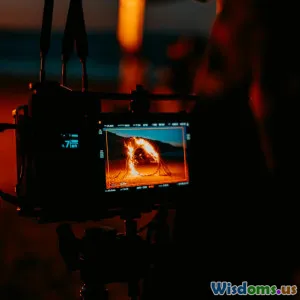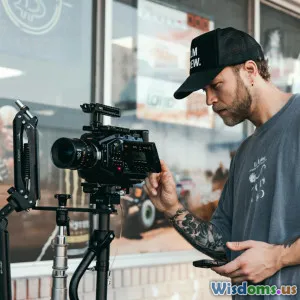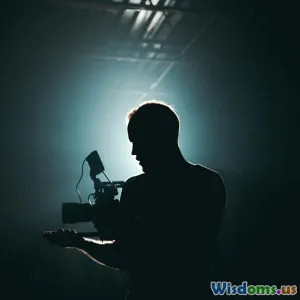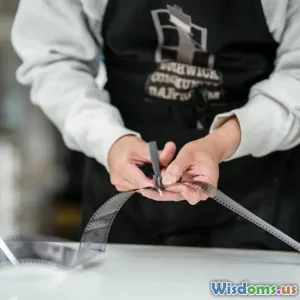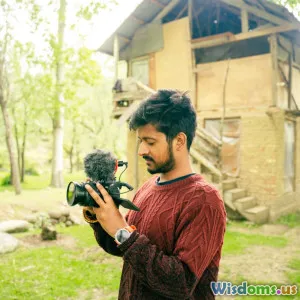
Behind the Scenes of Filmmaking
8 min read Explore the intricate world behind the scenes of filmmaking and discover how movies come to life beyond the camera. (0 Reviews)
Behind the Scenes of Filmmaking: A Cinematic Journey
Imagine sitting in a dark theater, the screen illuminating a compelling story that grips your attention. What you see is the polished final product, a seamless blend of visuals, sound, and emotion. But what happens before the credits roll is a complex tapestry of creativity, determination, and collaboration. Welcome to the captivating world behind the scenes of filmmaking, where magic is crafted far from the limelight.
Introduction: The Hidden Engine of Cinema
Filmmaking is often romanticized through stars and directors, but the real heartbeat lies behind the camera. From the initial script to the final frame, an army of professionals works in unison, transforming abstract ideas into visual narratives that resonate worldwide. This article uncovers that hidden engine—revealing the roles, challenges, and artistry involved in bringing a film to life.
The Pre-Production Blueprint: Foundations of a Film
Every successful film begins with meticulous planning, often months or years ahead of shooting.
Scriptwriting and Storyboarding
The screenplay is the blueprint. Renowned writers like Aaron Sorkin emphasize the screenplay as the film’s soul: “What guides how a film feels, sounds, and ultimately moves people” (Sorkin, 2015). Storyboarding complements this by visually mapping each scene. For example, Pixar's development process invests heavily in storyboards to envision emotions and pacing, ensuring coherence before a single frame is shot.
Casting: Assembling the Cast
Casting directors find actors who breathe life into characters. Jennifer Lawrence’s breakthrough role in "Winter’s Bone" was a mix of casting insight and trust in raw talent, highlighting how crucial this stage is to authenticity.
Location Scouting and Set Design
Locations shape the story’s atmosphere—a gritty urban environment versus a sweeping desert landscape impact tone substantially. Iconic films like "Inception" required multiple countries and constructed sets tailored to narrative demands, such as the rotating hallway scene crafted by a dedicated team.
Production: Capturing the Vision
This phase involves turning designs and scripts into tangible footage.
Directing and Cinematography
Directors like Greta Gerwig emphasize collaboration "behind the camera," ensuring the actors’ performances and cinematic choices align with the story. Meanwhile, cinematographers like Roger Deakins use lighting and camera techniques to evoke mood. In "Blade Runner 2049," Deakins’ use of color and light immersed viewers in a dystopian future firmly grounded in visual storytelling.
Sound and Lighting
Proper lighting is essential and can take hours per scene; for example, Stanley Kubrick was known for his obsession with lighting precision, contributing to the haunting aura of "The Shining." Sound teams capture ambient noise, dialogue, and foley effects—all stitched to enhance realism.
Stunts and Special Effects
Safety and creativity converge in stunt work. Tom Cruise famously performs many own stunts, supported by specialists ensuring actors survive intense sequences. Additionally, practical effects often blend with CGI—a technique perfected by franchises like "The Lord of the Rings," where physical sets combined with digital enhancements heighten immersion.
Post-Production: The Art of Polishing
The raw footage alone isn’t enough until artful editing and sound mixing bring it to life.
Editing: Shaping the Story
Editors like Thelma Schoonmaker have crafted unforgettable pacing and tension, as evident in Martin Scorsese’s films. Editing dictates tempo, focusing on narrative clarity and emotional resonance.
Visual Effects (VFX)
Films today are often unrecognizable without digital post-production. Avengers: Endgame involved thousands of digital artists orchestrating intricate battles and character animations. The seamless integration with live-action shots relies on both technology and artistic vision.
Sound Design and Score
Sound designers enrich worlds by layering effects, while composers create scores that define tone. Hans Zimmer’s work on "Inception" blends traditional orchestration with electronic elements to evoke complex feelings.
Color Grading
Subtle shifts in color grading—darker shadows, warmer highlights—help establish scenes’ emotional subtext. Netflix’s "The Queen’s Gambit" uses distinct palettes to mirror character progression and mood.
Challenges and Triumphs Behind the Camera
The filmmaking process is a delicate balance of art, technology, and human dynamics.
Budget and Time Constraints
Films like "Mad Max: Fury Road" faced daunting budget constraints and exhaustive shooting schedules, yet their inventive approach yielded one of the most praised action movies of the decade.
Coordinating Large Crews
A single film can involve hundreds of crew members across departments, requiring exceptional project management and clear communication. Using tools like scheduling software and daily call sheets ensures efficiency.
Innovation in Filmmaking Technology
From the early days of film reels to 8K digital cameras and virtual production using LED volumes (as seen in "The Mandalorian"), technology continues reshaping possibilities, expanding creative horizons.
Conclusion: Appreciating the Collective Craft
Every frame we admire is a testament to the tireless effort of its creators—writers, actors, cinematographers, editors, and countless others. Filmmaking is the ultimate collaborative art, merging vision with technical prowess and relentless passion. Understanding these behind-the-scenes intricacies deepens our appreciation, encouraging budding artists and enthusiasts to explore the craft.
So next time you marvel at a cinematic masterpiece, remember the symphony of processes, innovation, and human dedication humming forth behind the camera—because behind every great story told on screen lies a greater story of creation itself.
References
- Sorkin, Aaron. (2015). Screenplays: Building a Story
- Interviews with Roger Deakins and Greta Gerwig (Various Film Journals)
- Insider accounts on production from "Blade Runner 2049" and "Mad Max: Fury Road" documentaries
- Visual Effects Society Annual Reports
- "The Mandalorian" virtual production innovation articles
This article aims to inspire film lovers and aspiring filmmakers alike to peek beyond the surface and embrace the artistry beneath the art of cinema.
Rate the Post
User Reviews
Popular Posts










